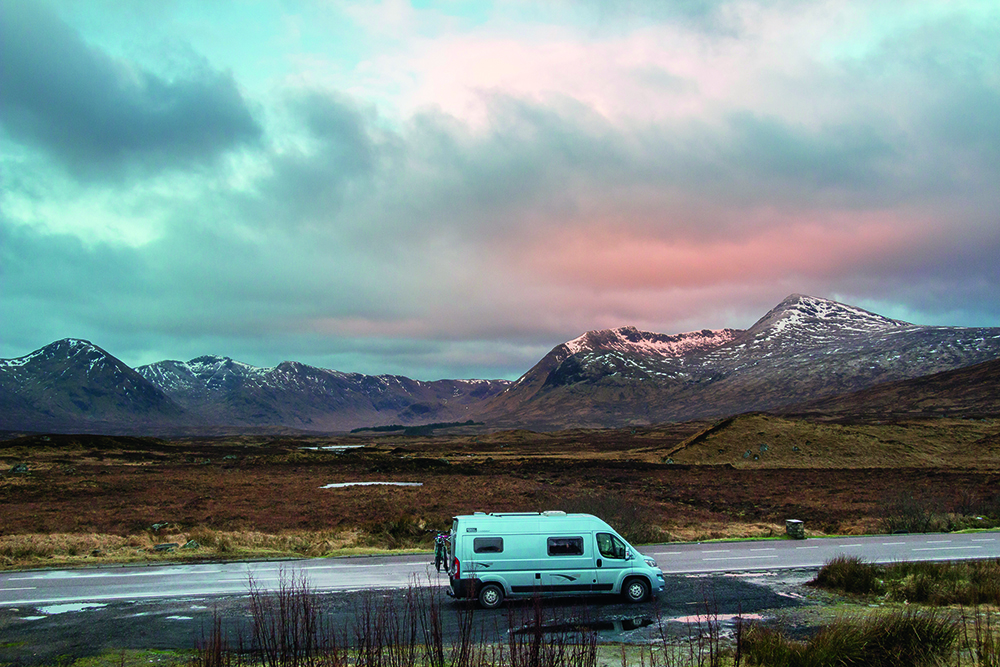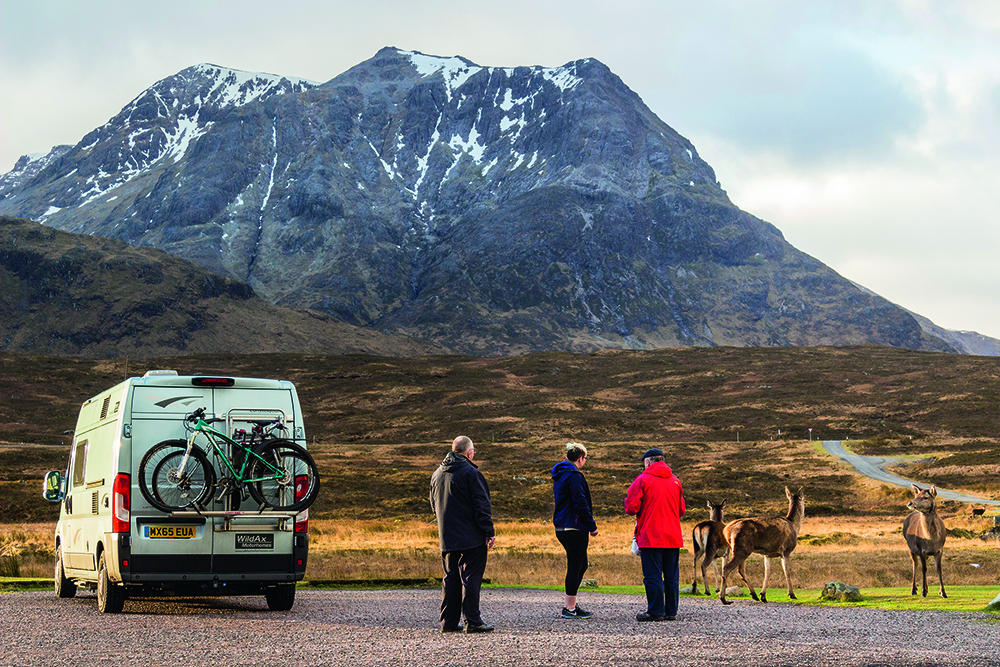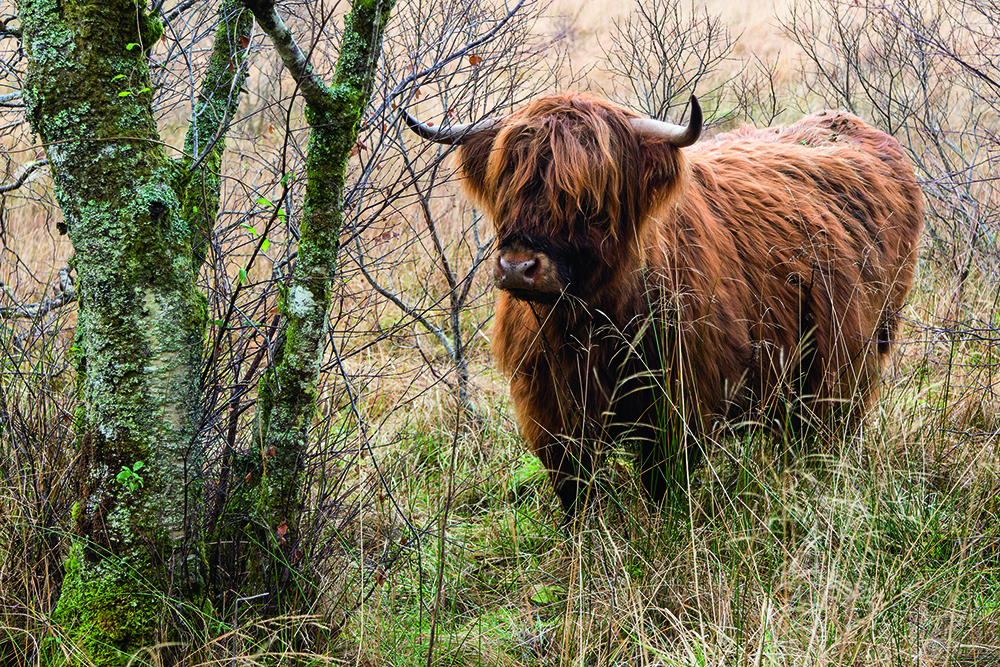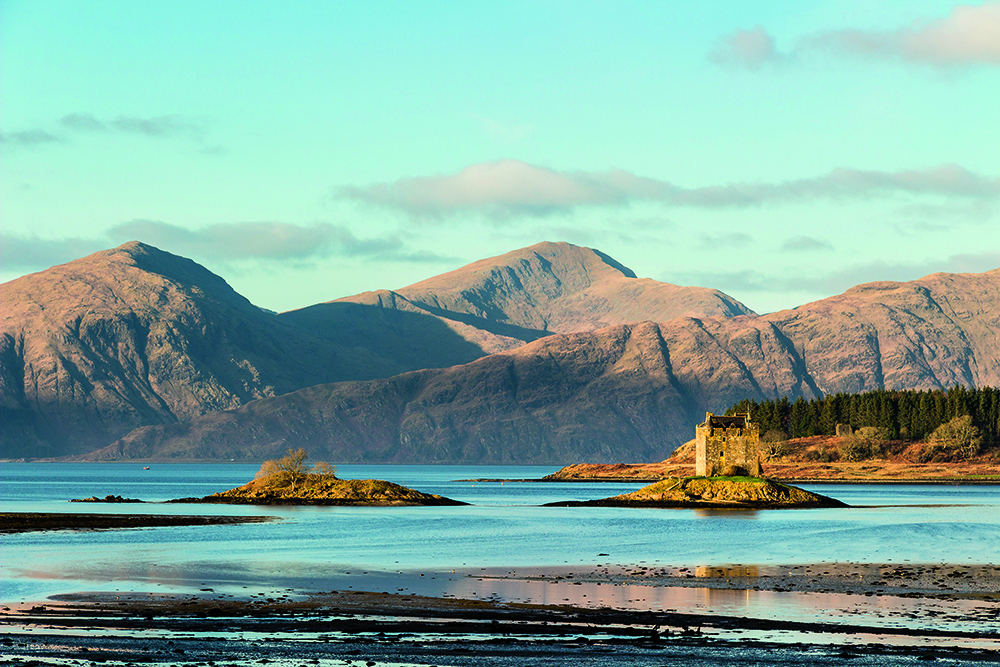Motorhome travel: A wintry weekend in Scotland

I leave our motorhome, Stella, for a few minutes while I take photographs of the iconic Glencoe mountain, Buachaille Etive Mor. On my return, I find three people hand-feeding a group of red deer hinds beside the ’van. I approach quietly and ask the man holding the bag what he is feeding them. “Carrots and bananas,” he replies. I knew that the lawns of the King’s House Hotel were a good place to see wild red deer, but I had been expecting to need a telephoto lens!
The mountains are fading in and out of sight as snow flurries drift down the glen. Photographically, the conditions are what I would call ‘atmospheric’. In my quest for pictures, we make several more stops – at Black Rock Cottage by Glencoe’s ski centre, at the Meeting of Waters below the Three Sisters of Glencoe and in Glencoe village. It is New Year’s Day and we left home early, driving in the dark along Loch Earn and through Crianlarich. We don’t see other vehicles until we are crossing Rannoch Moor and then it seems that every third one is a motorhome. Are we motorhomers a particularly hardy bunch or is it simply that we have discovered the secret of being comfortable while being able to enjoy the outdoors in all weathers?

In the depths of winter it is easy to become a bit stir crazy indoors, so escaping to the wilds for nature watching and exercise is good for both mind and body. Or, at least, that is what Andrew and I told ourselves when we booked three nights at Lagnaha Farm in Duror, on the west coast of Scotland. The village is in Appin, a historic district where the Argyll and Highland regions meet. The Camping and Caravanning Club Certificated Site is on the A828, which is quieter than most B roads. We easily find the entrance opposite the village hall and receive a warm welcome on arrival.
By now the sun has broken through, casting a warm light over our surroundings, which include a field of Clydesdale horses, a passion of the campsite owners. The mountain, Beinn a’ Bheithir, rises steely to the east and lower Ardsheal Hill juts into the sea on the peninsula out to the west. One of our resolutions is to climb a hill on New Year’s Day so, after lunch in Stella, we boot up for a walk up Ardsheal Hill. The map shows a track zigzagging up to a mast not far below the summit. It proves to be steep and unsurfaced, but offers an easy walking route through the rushes and heather. Our collie, Braan, loves this sort of terrain; she drops stalks of heather at our feet, begging us to throw them into the keen wind for her to chase.
From the summit trig point we have a superb view over Loch Linnhe, a long finger of sea running up to Fort William and down to the islands of Balnagowan, Shuna, Lismore and Mull. It is bitingly cold so Andrew and Braan soon descend to the campsite, but I have my thermals and a camera and want to catch the sunset. The light has an ethereal glow, thanks to all the sea spray in the air. I hunker down to enjoy the last of the golden rays.
The next day we decide to take a longer walk, circumnavigating the Ardsheal peninsula. A gate from the camping field leads directly onto a disused railway line, now a surfaced path that is part of the Caledonia Way (National Cycle Route 78). The campsite is roughly midway along the 48-mile stretch that links Oban and Fort William. We follow the path northwards to Kentallen Bay, where we cut down to join a private road that leads around the north of the peninsula. After passing the entrance to Ardsheal House, we follow a muddy track that soon divides. The hillside path looks boggy, so we decide to follow the coast.

Our route passes some free-range Highland cattle, after which we pick our way through the windswept trees between tussocky moorland and rocky shore. Woodcock burst out of the heather in front of us and fly away fast and low. We find a stretch of easier walking on short turf past Back Settlement, where just one isolated house remains amid the ruins of others.
During our picnic lunch we watch a family of bullfinches flitting around a willow and, soon after resuming our walk, we have another close view of wildlife. Andrew suddenly points towards the sea and I spot what I at first take to be a seal’s head just below us. But, as it dives, I realise that it is actually a big dog otter. The otter gradually works his way along the shore, repeatedly diving into the seaweed and returning to the surface to throw back his head and swallow down his catch. I guess he is finding crabs among the kelp. Of course, at that point I have a wide-angle lens on my camera and am too transfixed to take a picture until he has passed us!
The walking becomes easier once we turn the southwest corner of the peninsula and find a path threading across the salt marsh behind a string of three bays. We join a minor road behind Cuil Bay, the largest and sandiest beach. After crossing the A828, we pick up the cycle path for the last two miles back to the campsite. We have walked nearly eight miles and are all ravenous for dinner, which we soon rustle up in Stella.
We wake to a Scotch mist that shrouds the hills and dampens us with a smirr of moisture. Never mind, we have planned the ideal walk – in Glasdrum Wood National Nature Reserve. Situated on sheltered Loch Creran, it has a surfaced mile-long trail circuiting the Atlantic oak woods that cling to the hillside. This is Scotland’s rainforest and, in the damp conditions, the thick moss covering rocks and trees glows an almost luminous green. Lichens cling from the branches, ferns sprout from the trunks and a lively burn cascades over boulders.
By the time we return to Stella, it has become a dreich day of drenching drizzle, so we head to Port Appin to indulge ourselves in one of the area’s finest eateries. Our mussels and chips in The Pierhouse Hotel are deliciously fresh, whilst the couple next to us are enjoying enormous seafood platters. We gaze out of the window at the little boat that serves as a passenger ferry to Lismore, a beautifully green and fertile island. But, in the wet, we choose to go back to the campsite to read and relax.

On our last day we wake to clear skies and a frost and are determined to pack in as much as possible. The campsite owners say we can depart whenever we want, so we take a trip north on our bikes before leaving, pedalling at a gentle pace because Braan is trotting along beside us. At Kentallen, the cycle path climbs above houses to an information board where we have a superb view across Loch Linnhe to the rugged hills of Morvern, bathed in early morning sunshine. Our destination isn’t far and we have a specific purpose in mind – a coffee in the Holly Tree Hotel at Kentallen. The dog-friendly hotel incorporates the old railway station where trains once connected with the steamer that called at the pier. It’s a pleasant place to relax and enjoy the view.
After saying goodbye to our friendly hosts at Lagnaha Farm, we drive south with the aim of returning home on the A85 Oban road. It’s a glorious day and we find a lovely spot overlooking Castle Stalker for lunch. The fourteenth century castle straddles a tiny islet in Loch Laich and was built as a clan stronghold by the Stewarts of Appin. During the summer months there are occasional tours by boat to the castle, but we have to satisfy ourselves with simply drinking in the splendid scenery and taking a little walk along the cycle path that uses the old railway bridge across the loch.
We continue south through Benderloch and drive over the Connel Bridge just east of Oban. Its iron girder construction hints at the original purpose of this cantilever bridge – to carry a railway across the mouth of Loch Etive. We stop again to admire the view and make afternoon tea. The tide is flowing out under the bridge, with whirlpools and eddies boiling in the Falls of Lora. A glorious sunset of pinks and golds paints the sea as we watch the sun sink behind a wooded hill in the southwest. It’s a lovely end to our trip. We haven’t done everything I’d planned, such as visiting Oban Sea Life Centre or walking under the soaring conifers of Sutherland’s Grove, but we have filled our lungs with fresh air and reconnected with nature during the shortest days of winter.
This feature was originally published in the February 2018 issue of MMM magazine. Subscribe to MMM magazine today for your monthly dose of motorhome travel inspiration.








.jpg)


Recent Updates
Engine management lights: all you need to know
What is the engine management light? What does it mean, and what do I have to do? ...
Motorhome air suspension: all you need to know
Motorhomes are heavy and the additional weight of equipment and height of the bodywork can increase the loads ...
Motorhome WiFi: how to get better motorhome internet
Staying connected on the move is more and more essential, so relying on campsite WiFi isn't an option – here ...
A class of their own - our guide to A-class motorhomes
Thinking of trading up to an A-class, or even going straight to the top of the motorhome tree? We guide you ...
Explore overseas on a motorhome dream tour
Enjoy exotic travel in a campervan or motorhome by hiring, swapping with someone else or exporting your ...
Motorhome water systems: everything you need to know
On-board water is an important part of every motorhome – here’s everything you need to know ...
Campervanning in Europe: what you need to know
Whether you're planning a leisurely drive through the French countryside, navigating bustling city streets in ...
Campervan security: all you need to know
With thefts on the increase, it’s important to know how to keep your campervan secure and prevent campervan ...
Campervan furniture: everything you need to know
Our campervan experts guide you through all the essentials for your campervan, including tables, chairs, ...
Campervan finance: how to fund your purchase
Here we look at the different types of campervan finance available, to help you decide what’s the best option ...
Other Articles
Britain’s best used motorhomes
Want a great motorhome without paying the premium for a new one? Here's a guide to the best you can get in the pre-owned market for each layout, ...
Which motorhome? Choosing the perfect motorhome for you
Choosing a motorhome or campervan is one of the biggest buying decisions you’ll ever make, so it's important ...
Campervan washroom essentials: stay fresh on the road
Our guide will take you through the campervan washroom essentials you'll need so you're well-prepared for ...
Dogs in campervans: all you need to know
Follow our advice and your dog will enjoy campervanning as much as you do ...
Electric campervans: all you need to know
Our guide will take you through everything you need to know about electric campervans and what the future ...
Motorhome electrics: a complete guide to your motorhome electrical set-up
Motorhome electrics can dramatically enhance the convenience and comfort of your vehicle – but they can be ...
Lighting for campervans: all you need to know
We guide you through all the lighting options available for you and your campervan, including interior ...
Electric bikes for motorhomes: our ultimate guide
Read our comprehensive guide to electric bikes for motorhome owners, helping you add electric power to your ...
Our guide to 'cheap' motorhomes in 2024
If you're on the hunt for an affordable new motorhome, this is the best place to start – we've rounded up a ...
Campervans in winter: all you need to know
Here's your guide to preparing your campervan for the colder months, whether you will be using it or putting ...